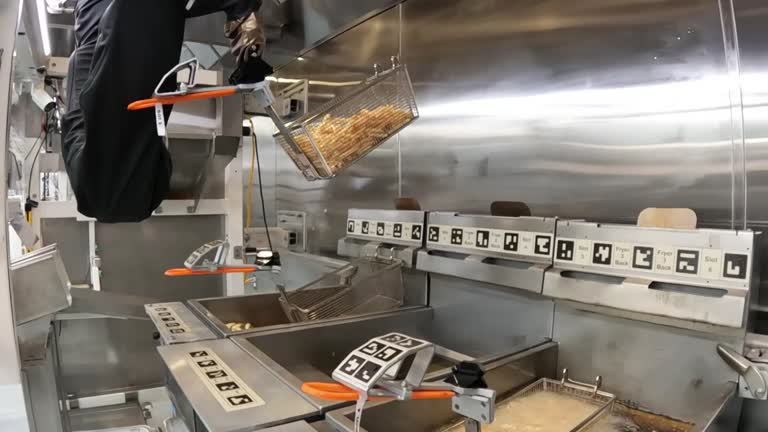French fries are going hi-tech, thanks to a laboratory in California.
Miso Robotics in Pasadena has started rolling out its ‘Flippy 2’ robot, which cuts the human out of a big chunk of the cooking process in fast-food restaurants.
A huge robotic arm – similar to those seen in car plants and manufacturing – powered by cameras and artificial intelligence does everything from taking frozen French fries, onion rings and other foods from the freezer, cooks them in oil, then deposits them ready for serving. The machine can cook several meals with different recipes simultaneously removing the need for catering staff and, says Miso, speed up the process at drive-thru’s.
“When an order comes in through the restaurant system, it automatically spits out the instructions to Flippy, takes a frozen product, fries it for the precise amount of time, and puts the finished product in the end. It does it faster or more accurately, more reliably and happier than most humans do it” explains Mike Bell, Miso Robotics’ Chief Executive as he proudly shows ‘Flippy 2’ off to Reuters.
“This technology utilizes a whole bunch of computer vision. There’s cameras throughout the system, including right here we have these food identification cameras. The cameras not only guide the robot and tell it it exactly where it is in space and how to move through this area. But also it identifies the food type and it knows the recipe for each one”, he adds.
Success
You are now signed up for our newsletter
Success
Check your email to complete sign up
‘Flippy’ was in development for five years before recently becoming commercially available. It took painstaking effort not just to engineer and code, but to learn the intimacies of the kitchen:
“We have to have a really good understanding of the food science in order to make sure the food quality is there, how different food sticks together, how it cooks over time, how the temperature and the heat go into it” explains Rob Anderson, Head of Mechanical Engineering and one of the key team-members who got Flippy 2 to market.
The Flippy name comes from the original machine, designed to flip burgers. But once the team at Miso Robotics had finished that model, they realized from speaking to restaurants that there was way more of a bottleneck around the frying station, particularly late at night.
As the original Flippy sits in the corner of the room, almost watching the newer model take its glory (Miso says ‘Flippy 1’ is “on sabbatical”), a huge fleet of Flippy 2’s busily cook hundreds of French fries and onion rings, timed to the second.
“When we put a robot into a location, the customers that come up and order, they all take pictures, they take videos, they ask a bunch of questions. And then the second time they come in, they seem not to even notice it, just take it for granted”, Bell says.
A big screen shows engineers where ‘Flippy 2’ is in operation, and lets them watch in real-time to help trouble shoot in case of any issues. The robot has been adopted by a number of restaurant chains.
“What you can see here is we have locations in San Diego for Jack in the Box, many throughout the Midwest with White Castle, several on the West Coast with Cali Burger. And these are just some of the robots we’ve got deployed in the world today where our engineers are keeping eyes on making sure everything works well” says Bell. He tells Reuters of at least three other huge national chains that have also adopted ‘Flippy’, but says some are hesitant to advertise the fact because of sensitivities about fears that robots could lead to job losses.
“The task that the humans are most happy to offload are tasks like the fry station. And so it’s the task that’s.. It’s the position that’s often hardest to fill, it’s hardest to retain. And so it really doesn’t take anything away from restaurant workers. In reality, they’re delighted to have the help so they can do other things”, explains Bell.
The lab is home to around 90 engineers who sit huddled behind desks, driving screws into prototypes and working on computer code. This is a company that wants to reimagine both food and drink. Bell shows Reuters ‘Sippy’, Miso’s robotic attempt to make the perfect drink. It’s still in development and has wires hanging out, but a slickly-produced video shows what Miso Robotics is aiming for.
“Sippy will be able to take an order from a customer and put out a perfectly poured drink with a lid on it and a straw and all group together” explains Bell before pivoting to a smart coffee machine, designed for hotels and restaurants, that can tell when a cup of coffee has gone off.
He’s keen to point out that the star attraction here, ‘Flippy 2’ is an addition to the kitchen, not a replacement and says they’re not seeking to drive out the human element, rather bring the restaurant industry up to speed with the changes others have adopted:
“The restaurant industry has not been eager adopters of technology. When you look at the restaurant industry today, the last really big innovation was the dishwasher in many ways. And so what’s happened is this technology has quickly caught up and is now solving these problems back-of-house, very reliably. There’ll be a point in time when humans walk into a restaurant and look at a robot and say ‘hey, remember the old days when humans used to do that kind of thing?’ And those days.. it’s coming.. It’s just a matter of, you know, how quick.”
By Reuters. (Production: Phil Lavelle & Sandra Stojanovic)














